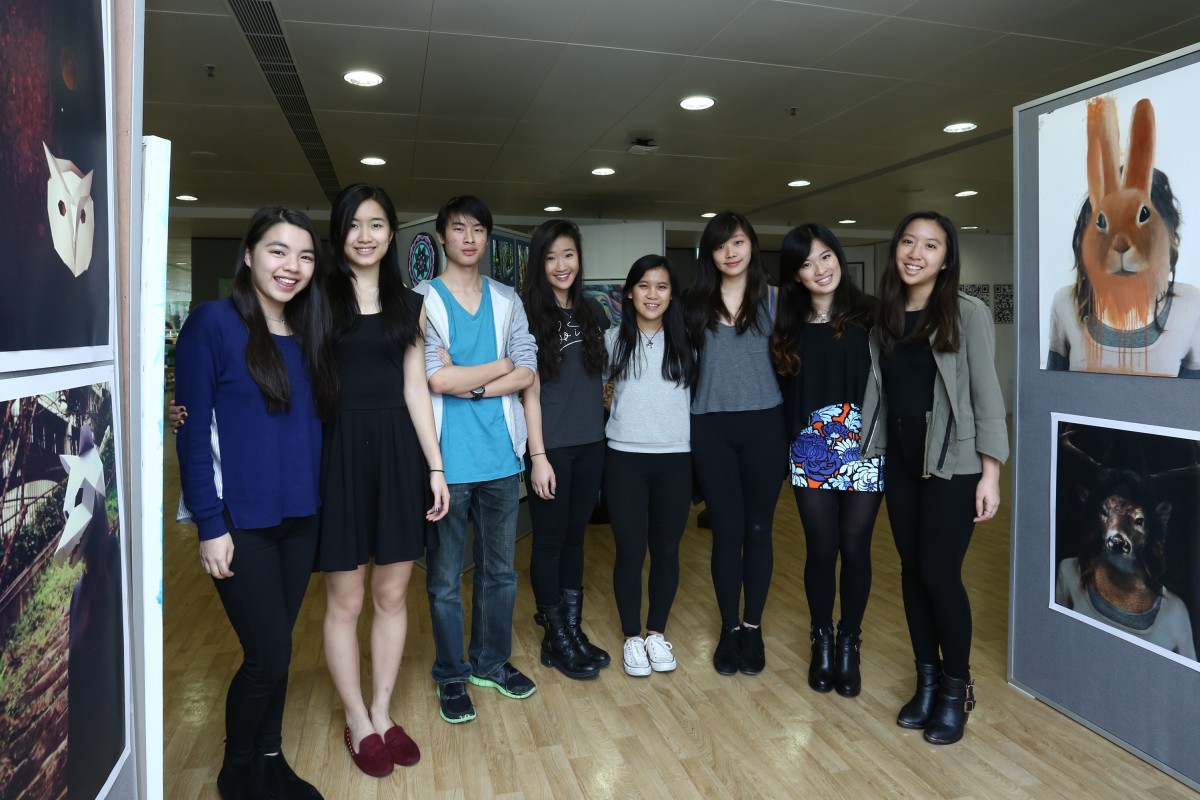 From left: Alexandra Cheong, Jasmine Chung, Nicholas Koo, Larissa Li, Jane Lui, Stefanie Tao, Hilaire Wong and Vanessa Wong
From left: Alexandra Cheong, Jasmine Chung, Nicholas Koo, Larissa Li, Jane Lui, Stefanie Tao, Hilaire Wong and Vanessa WongThe International Baccalaureate (IB) programme brings to mind rigorous tests, tough academics and endless hours of study. But what about creativity and artistic expression?
At German Swiss International School, 10 students have completed the school’s first IB Visual Arts course. The two-year programme ended with an exhibition by the students held at the school where they showcased their efforts.
But IB and art don’t usually go together in Hong Kong. “A lot of schools that offer IB don’t actually offer an art course,” explains Larissa Li, 17, and one of the students who completed the programme at GSIS. “So instead, they have to take maybe economics or a science in place of the arts.”
And the 10 students who completed the course all agree that this is a big mistake for schools to make. “Subjects like sciences and maths, they’re much more valued over humanities and the arts,” says Hilaire Wong, 18. “because it has that sort of rationality, that sort of narrow-mindedness of just going for a vocation and avoiding that creative, uncertain direction.”
But the students think the programme is about much more than just passing course requirements.
Vanessa Wong, 17, explains that in their first year the students were guided more closely by their teachers. “But then this year we were allowed to go completely in our own direction,” she says. This led to each student developing their own personal artistic style as they delved into topics for which they found a passion.
Each area of the exhibition space is completely different, and it’s clear that each student found their own expressive voice within their artwork.
With topics ranging from architecture to steampunk, dreams, generations and even social problems like eating disorders and depression, each student found an important issue where their art could be applied. “I think between the 10 of us we’ve covered a huge range of topics and issues in society, whether it be small or big,” says Larissa. “We’ve explored in our own way and we produced a piece of work that we feel would best describe the situation.”
Putting their exhibition together was also part of the challenge, as the students had to curate their own spaces. Jasmine Chung, 17, says selecting the right pieces from across the two-year course was difficult. “We had to put all the pieces that are connected to each other together, and in a way that’s coherent and easier for the viewer to see,” she explains. “And I also had to be really selective about my work and only display the best ones.”
For Stefanie Tao, 18, it was about striking a balance between showing her topic but also her artistic journey. “I also incorporated work from the previous year, which shows my development,” she says, “which I also thought was important to be able to show the viewers how I developed my artistic skills.”
This process of self-selection and analysis is a big part of the course, and an important skill which transfers to other disciplines, says Hilaire. “We’ve been encouraged to reflect and look at the good and bad and what could be improved,” she says. “[Visual arts] has definitely encouraged me to be more open-minded, and to be more receptive to my environment.”
Jasmine agrees. “I’ve learned to develop and extend my ideas from the starting point into the final product,” she says. This is a skill Jasmine says will be particularly useful when she studies architecture at university. Stephanie and Alexandra Cheong, both 18, are also looking to study architecture, and while they aren’t sure if they will continue with visual arts directly, they know they can carry over many of the skills they’ve learned in the course.
Popular Japanese artist Yoshitomo Nara brings his Life is Only One exhibit to Hong Kong
Nicholas Koo, 17, isn’t looking at a career in fine art, but plans on going into game design and computer science. “Most people have this understanding that art is just pen and paper, just drawing things,” he says. “But there’s more to it than meets the eye. It’s really just a method of expressing yourself.”
The students all agree that being open to new ways of expressing yourself can help you no matter what you’re studying. “A lot of people choose to forget the art element, whether it be performing arts or fine arts, and I feel that closes a lot of doors,” says Larissa. “Art is something that really allows you to express yourself. And that’s not something that could be said for a lot of the other subjects that we do,” says Larissa.
And students shouldn’t be afraid to experiment and find their own voice in their art, either. “No matter what you’re told - ‘Don’t do this! Don’t do that! - with art just do it anyway,”says Ashley Dear, 17. “Because it’s art and art is expression and it’s your passion, your emotion. So just do whatever you want.”
